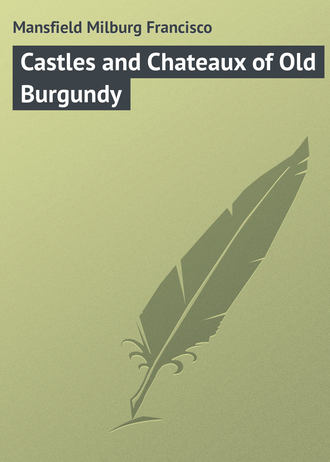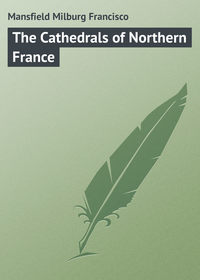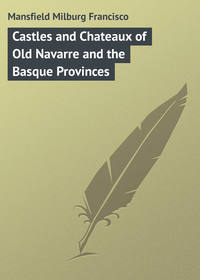 полная версия
полная версияCastles and Chateaux of Old Burgundy
The great tower, or citadel, a part of the royal chateau where the king lodged on his brief visits to his pet city, was intended at once to serve as a fortress and a symbol of dignity, and it played the double part admirably. Attached to this tower on the north was the Royal Chateau de Salles, a favourite abode of the royalties of the thirteenth century. Little or nothing of this dwelling remains to-day save the walls of the chapel, and here and there an expanse of wall built up into some more humble edifice, but still recognizable as once having possessed a greater dignity. There are various fragmentary foundation walls of old towers and other dependencies of the chateau, and the old ramparts cropping out here and there, but there is no definitely formed building of a sufficiently commanding presence to warrant rank as a historical monument of the quality required by the governmental authorities in order to have its patronage and protection.
Philippe-Auguste, in 1204, assembled here a parliament where the celebrated ordonnance “Stabilementum Feudorum” was framed. This alone is enough to make Villeneuve stand out large in the annals of feudalism, if indeed no monuments whatever existed to bring it to mind. It was the code by which the entire machinery of French feudalism was put into motion and kept in running order, and for this reason the Chateau de Salles, where the king was in residence when he gave his hand and seal to the document, should occupy a higher place than it usually does. The Chateau de Salles was called “royal” in distinction to the usual seigneurial chateau which was merely “noble.” It was not so much a permanent residence of the French monarchs as a sort of a rest-house on the way down to their Burgundian possession after they had become masters of the duchy. The donjon tower that one sees to-day is the chief, indeed the only definitely defined, fragment of this once royal chateau which still exists, but it is sufficiently impressive and grand in its proportions to suggest the magnitude of the entire fabric as it must once have been, and for that reason is all-sufficient in its appeal to the romantic and historic sense.
Situated as it was on the main highway between Paris and Dijon, Villeneuve occupied a most important strategic position. It spanned this old Route Royale with its two city gates, and its ramparts stretched out on either side in a determinate fashion which allowed no one to enter or pass through it that might not be welcome. These graceful towered gateways which exist even to-day were the models from which many more of their kind were built in other parts of the royal domain, as at Magny-en-Vexin, at Moret-sur-Loing, and at Mâcon.
A dozen kilometres from Villeneuve-sur-Yonne is Joigny, almost entirely surrounded by a beautiful wildwood, the Forêt National de Joigny. Joigny was one of the last of the local fiefs to give up its ancient rights and privileges. The fief took rank as a Vicomté. Jeanne de Valois founded a hospice here – the predecessor of the present Hotel Dieu – and the Cardinal de Gondi of unworthy fame built the local chateau in the early seventeenth century.
The Chateau de Joigny, as became its dignified state, was nobly endowed, having been built to the Cardinal’s orders by the Italian Serlio in 1550-1613. To-day the structure serves the functions of a schoolhouse and is little to be remarked save that one hunts it out knowing its history.
There is this much to say for the schoolhouse-chateau at Joigny; it partakes of the constructive and decorative elements of the genuine local manner of building regardless of its Italian origin, and here, as at Villeneuve, there is a distinct element of novelty in all domestic architecture which is quite different from the varieties to be remarked a little further north. There, the town houses are manifestly town houses, but at Joigny, as often as not, when they advance beyond the rank of the most humble, they partake somewhat of the attributes of a castle and somewhat of those of a palace. This is probably because the conditions of life have become easier, or because, in general, wealth, even in mediæval times, was more evenly distributed. Certainly the noblesse here, as we know, was more numerous than in many other sections.
Any one of a score of Joigny’s old Renaissance houses, which line its main street and the immediate neighbourhood of its market-place, is suggestive of the opulent life of the seigneurs of old to almost as great a degree as the Gondi chateau which has now become the École-Communal.
Of all Joigny’s architectural beauties of the past none takes so high a rank as its magnificent Gothic church of Saint Jean, whose vaultings are of the most remarkable known. Since the ruling seigneur at the time the church was rebuilt was a churchman, this is perhaps readily enough accounted for. It demonstrates, too, the intimacy with which the affairs of church and state were bound together in those days. A luxurious local chateau of the purely residential order, not a fortress, demanded a worthy neighbouring church, and the seigneur, whether or not he himself was a churchman, often worked hand in hand with the local prelate to see that the same was supplied and embellished in a worthy manner. This is evident to the close observer wherever he may rest on his travels throughout the old French provinces, and here at Joigny it is notably to be remarked.
Saint Fargeau, in the Commune of Joigny, is unknown by name and situation to the majority, but for a chateau-town it may well be classed with many better, or at least more popularly, known. On the principal place, or square, rises a warm-coloured winsome fabric which is the very quintessence of mediævalism. It is a more or less battered relic of the tenth century, and is built in a rosy brick, a most unusual method of construction for its time.
The history of the Chateau de Saint Fargeau has been most momentous, its former dwellers therein taking rank with the most noble and influential of the old régime. Jacques Coeur, the celebrated silversmith of Bourges and the intimate of Charles VII, Mademoiselle de Montpensier, and the leader of the Convention – Lepelletier de Saint Fargeau – all lived for a time within its walls, to mention only three who have made romantic history, though widely dissimilar were their stations.
An ornate park with various decorative dependencies surrounds the old chateau on three sides and the ensemble is as undeniably theatrical as one could hope to find in the real. In general the aspect is grandiose and it can readily enough be counted as one of the “show-chateaux” of France, and would be were it better known.
Mlle. de Montpensier – “la Grande Mademoiselle” – was chatelaine of Saint Fargeau in the mid-seventeenth century. Her comings and goings, to and from Paris, were ever written down at length in court chronicles and many were the “incidents” – to give them a mild definition – which happened here in the valley of the Yonne which made good reading. On one occasion when Mademoiselle quitted Paris for Saint Fargeau she came in a modest “carosse sans armes.” It was for a fact a sort of sub-rosa sortie, but the historian was discreet on this occasion. Travel in the old days had not a little of romanticism about it, but for a lady of quality to travel thus was, at the time, a thing unheard of. This princess of blood royal thus, for once in her life, travelled like a plebeian.
Closely bound up with the Sennonais were the fiefs of Auxerre and Tonnerre, whose capitals are to-day of that class of important provincial cities of the third rank which play so great a part in the economic affairs of modern France. But their present commercial status should by no means discount their historic pasts, nor their charm for the lover of old monuments, since evidences remain at every street corner to remind one that their origin was in the days when knights were bold. The railway has since come, followed by electric lights and automobiles, all of which are once and again found in curious juxtaposition with a bit of mediæval or Renaissance architecture, in a manner that is surprising if not shocking. Regardless of the apparent modernity roundabout, however, there is still enough of the glamour of mediævalism left to subdue the garishness of twentieth century innovations. All this makes the charm of French travel, – this unlocked for combination of the new and the old that one so often meets. One can not find just this same sort of thing at Paris, nor on the Riviera, nor anywhere, in fact, except in these minor capitals of the old French provinces.
The Comté d’Auxerre was created in 1094 by the Roi Robert, who, after the reunion of the Burgundian kingdom with the French monarchy, gave it to Renaud, Comte de Nevers, as the dot of one, Adelais, who may have been his sister, or his cousin – history is not precise. The house of Nevers possessed the countship until 1182, when it came to Archambaud, the ninth of the name, Sire de Bourbon. One of his heirs married a son of the Duc de Bourgogne and to him brought the county of Auxerre, which thus became Burgundian in fact. Later it took on a separate entity again, or rather, it allied itself with the Comtes de Tonnerre at a price paid in and out of hand, it must not be neglected to state, of 144,400 livres Tournois. The crown of France, through the Comtes d’Auxerre, came next into possession, but Charles VII, under the treaty of Arras, ceded the countship in turn to Philippe-le-Bon, Duc de Bourgogne. Definite alliance with the royal domain came under Louis XI, thus the province remained until the Revolution.
With such a history small wonder it is that Auxerre has preserved more than fleeting memories of its past. Of great civic and domestic establishments of mediævalism, Auxerre is poverty-stricken nevertheless. The Episcopal Palace, now the Préfecture, is the most imposing edifice of its class, and is indeed a worthy thing from every view-point. It has a covered loggia, or gallery running along its façade, making one think that it was built by, or for, an Italian, which is not improbable, since it was conceived under the ministership of Cardinal Mazarin who would, could he have had his way, have made all things French take on an Italian hue. From this loggia there is a wide-spread, distant view of the broad valley of the Yonne which here has widened out to considerable proportions. The history of this Préfectural palace of to-day, save as it now serves its purpose as a governmental administrative building, is wholly allied with that of Auxerre’s magnificent cathedral and its battery of sister churches.
Within the edifice, filled with clerks and officials in every cranny, all busy writing out documents by hand and clogging the wheels of progress as much as inefficiency can, are still found certain of its ancient furnishings and fittings. The great Salle des Audiences is still intact and is a fine example of thirteenth century woodwork. The wainscotting of its walls and ceiling is remarkably worked with a finesse of detail that would be hard to duplicate to-day except at the expense of a lord of finance or a king of petrol. Not even government contractors, no matter what price they are paid, could presume to supply anything half so fine.
It was at Auxerre that the art and craft of building noble edifices developed so highly among churchmen. The builders of the twelfth century were not only often monks but churchmen of rank as well. They occupied themselves not only with ecclesiastical architecture, but with painting and sculpture. One of the first of these clerical master-builders was Geoffroy, Bishop of Auxerre, and three of his prebendarys were classed respectively as painters, glass-setters and metal-workers.
The towering structure on the Place du Marché is to-day Auxerre’s nearest approach to a chateau of the romantic age, and this is only a mere tower to-day, a fragment left behind of a more extensive residential and fortified chateau which served its double purpose well in its time. It is something more than a mere belfry, or clock tower, however. It is called the Tour Gaillarde, and flanked at one time the principal breach in the rampart wall which surrounded the city. It is one of the finest specimens of its class extant, and is more than the rival of the great Tour de l’Horloge at Rouen or the pair of towers over which conventional tourists rave, as they do over the bears in the bear-pit, at Berne in Switzerland.
The entire edifice, the tower and that portion which has disappeared, formed originally the residence of the governor of the place, the personal representative of the counts who themselves, in default of a special residence in their capital, were forced to lodge therein on their seemingly brief visits. The names of the counts of Tonnerre and Auxerre appear frequently in the historical chronicles of their time, but references to their doings lead one to think that they chiefly idled their time away at Paris. That this great tower made a part of some sort of a fortified dwelling there is no doubt, but that it was ever a part of a seigneurial chateau is not so certain.
With respect to the part Auxerre played in the military science of the middle ages it is interesting to recall that the drum, or tambour, is claimed as of local origin, or at least that it was here first known in France, in the fourteenth century. No precise date is given and one is inclined to think that its use with the army of Edward III at Calais on the 3rd August, 1347, was really its first appearance across the Channel after all.
Above Auxerre the Yonne divides, or rather takes to itself the Armançon and the Seruin to swell its bulk as it flows down through the Auxerrois. Above lies the Avallonnais, where another race of seigneurs contribute an altogether different series of episodes from that of their neighbours. It remains a patent fact, however, that the cities and towns of the valley of the Yonne give one ample proof of the close alliance in manners and customs of all mid-France of mediæval times.
The inhabitants of this region are not a race apart, but are traditionally a blend of the “natural” Champenois and the “frank and loyal” Burgundian, – “strictly keeping to their promises, and with a notable probity in business affairs,” says a proud local historian. Here in this delightful river valley were bred and nourished the celebrated painter, Jean-Cousin; the illustrious Vauban, the builder of fortresses; the enigmatical Chevaliere d’Eon; the artist Soufflot, architect of the Pantheon; Regnault de Saint-Jean d’Angely, Minister of Napoleon; Bourrienne, his secretary and afterwards Minister of State under the Bourbons.
Following the Yonne still upwards towards its source one comes ultimately to Clamecy. Between Auxerre and Clamecy the riverside is strewn thickly with the remains of many an ancient feudal fortress or later chateaux. At Mailly-le-Chateau are the very scanty fragments of a former edifice built by the Comtes d’Auxerre in the fifteenth century, and at Chatel-Censoir is another of the same class. At Coulanges-sur-Yonne is the débris, a tower merely, of what must one day have been a really splendid edifice, though even locally one can get no specific information concerning its history.
From Clamecy the highroad crosses the Bazois to Chateau Chinon in the Nivernais. The name leads one to imagine much, but of chateaux it has none, though its nomenclature was derived from the emplacement of an ancient oppidum gaulois, a castrum gallo-romain and later a feudal chateau.
The road on to Burgundy lies to the southwest via the Avallonnais, or, leaving the watershed of the Yonne for that of the upper Seine, via Tonnerre and Châtillon-sur-Seine lying to the eastward of Auxerre.
CHAPTER III
AVALLON, VEZELAY AND CHASTELLUX
AVALLON owes its origin to the construction of a chateau-fort. It was built by Robert-le-Pieux, the son of Hugues Capet, in the tenth century. Little by little the fortress has crumbled and very nearly disappeared. All that remains are the foundation walls on what is locally called the Rocher d’Avallon, virtually the pedestal upon which sits the present city.
Avallon, like neighbouring Semur and Vezelay, sits snugly and proudly behind its rampart of nature’s ravines and gorges, a series of military defences ready-made which on more than one occasion in mediæval times served their purpose well.
It was in the old Chateau d’Avallon that Jacques d’Epailly, called “Forte Épice,” was giving a great ball when Philippe-le-Bon beseiged the city. Jacques treated the inhabitants with the utmost disrespect, even the ladies, and secretly quitted the ball just before the city troops surrendered. History says that the weak-hearted gallant sold out to the enemy and saved himself by the back door, and in spite of no documentary evidence to this effect the long arm of coincidence points to the dastardly act in an almost unmistakable manner.
Near Avallon are still to be seen extensive Roman remains. A Roman camp, the Camp des Alleux, celebrated in Gaulish and Roman history, was here, and the old Roman road between Lyons and Boulogne in Belgica Secundus passed near by.
It is not so much with reference to Avallon itself, quaint and picturesque as the city is, that one’s interest lies hereabouts. More particularly it is in the neighbouring chateaux of Chastellux and Montréal.
The Seigneur de Chastellux was one of the most powerful vassals of the Duc de Bourgogne. By hereditary custom the eldest of each new generation presented himself before the Bishop of Auxerre clad in a surplice covering his military accoutrements, and wearing a falcon at his wrist. In this garb he swore to support Church and State, and for this devotion was vested in the title of Chanoin d’Auxerre, a title which supposedly served him in good stead in case of military disaster. It was thus that the Maréchal de Chastellux, a famous warrior, was, as late as 1792, also a canon of the cathedral at Auxerre. It was, too, in this grotesque costume that the Chanoin-Comte d’Chastellux welcomed Louis XIV on a certain visit to Auxerre. At Auxerre, in the cathedral, one sees a monument commemorative of the Sires de Chastellux. It was erected by César de Chastellux under the Restoration, to replace the tomb torn down by the Chapter in the fifteenth century. This desecration, by churchmen themselves, one must remember, took place in spite of the fact that a Chastellux was even then a dignitary of the church.
Chastellux, beyond its magnificent chateau, is an indefinable, unconvincing little bourg, but from the very moment one sets foot within its quaintly named Hotel de Maréchal de Chastellux he, or she, is permeated with the very spirit of romance and mediævalism. The bridge which crosses the Cure in the middle of the village owns to the ripe old age of three hundred and fifty years, and is still rendering efficient service. This is something mature for a bridge, even in France, where many are doing their daily work as they have for centuries. Will the modern “suspension” affairs do as well? That’s what nobody knows! The hotel, or auberge rather, can not be less aged than the bridge, though the manner in which it is conducted is not at all antiquated.
A rocky, jagged pedestal, of a height of perhaps a hundred and fifty feet, holds aloft the fine mass of the Chateau de Chastellux. For eight centuries this fine old pile was in the making and, though manifestly non-contemporary as to its details, it holds itself together in a remarkably consistent manner and presents an ensemble and silhouette far more satisfactory to view than many a more popular historic monument of its class. Its great round towers, their coiffes and the pignons and gables of the roof, give it all a cachet which is so striking that one forgives, or ignores the fact that it is after all a work of various epochs.
Visitors here are welcome. One may stroll the corridors and apartments, the vast halls and the courtyard as fancy wills, except that one is always discreetly ciceroned by a guardian who may be a man, a woman, or even a small child. There is none of the espionage system about the surveillance, however, and one can but feel welcome. Blazons in stone and wood and tapestries are everywhere. They are the best, or the worst, of their kind; one really doesn’t stop to think which; the effect is undeniably what one would wish, and surely no carping critic has any right to exercise his functions here. There is not the least cause to complain if the furnishings are of non-contemporary periods like the exterior adornments, because the certain stamp of sincerity and genuineness over all defies undue criticism.
The Chateau de Chastellux dates, primarily, from the thirteenth century, with many fifteenth, sixteenth and seventeenth century restorations or additions which are readily enough to be recognized. From its inception, the chateau has belonged to the family of Beauvoir-de-Chastellux, the cadet branch of Anseric-de-Montréal.
Practically triangular in form, as best served its original functions of a defensive habitation, this most theatrical of all Burgundian chateaux is flanked by four great attached towers. The Tour de l’Horloge is a massive rectangular pile of the fifteenth century; the Tour d’Amboise is a round tower dating from 1592; the Tour de l’Hermitage and the Tour des Archives, each of them, also round, are of the sixteenth century. In the disposition and massiveness of these towers alone the Chateau de Chastellux is unique. Another isolated tower, even more stupendous in its proportions, is known as the Tour Saint Jean, and is a donjon of the ideally acceptable variety, dating from some period anterior to the chateau proper.
Moat-surrounded, the chateau is only to be entered by crossing an ornamental waterway. One arrives at the actual entrance by the usual all-eyed roadway ending at the perron of the chateau where a simple bell-pull silently announces the ways and means of gaining entrance. The domestic appears at once and without questioning your right proceeds to do the honours as if it were for yourself alone that the place were kept open.
The chief and most splendid apartment is the Salle des Gardes, to a great extent restored, but typical of the best of fifteenth century workmanship and appointments. Its chimney-piece, as splendid in general effect as any to be seen in the Loire chateaux, is but a re-made affair, but follows the best traditions and encloses moreover fragments of fifteenth century sculptures which are authentically of that period. The cornice of this majestic apartment bears the Chastellux arms and those of their allied families, interwoven with the oft repeated inscription, Monréal à Sire de Chastellux. In this same Salle des Gardes are hung a pair of ancient Gobelins, and set into the floor is a dainty morsel of an antique mosaic found nearby.
The modern billiard-room, also shown to the inquisitive, contains portraits of the Chancelier d’Aguesseau and his wife, and its fittings – aside from the green baize tables and their accessories – are well carried out after the style of Louis XIII. Good taste, or bad, one makes no comment, save to suggest that the billiard tables look out of place.
In what the present dweller calls the Salon Rouge are portraits and souvenirs of a military ancestor Comte César de Chastellux, who, judging from his dress and cast of countenance, must have been a warrior bold of the conventional type.
After the Salle des Gardes the Grand Salon is the most effective apartment. Its wall and ceiling decorations are the same that were completed in 1696, and incorporated therein are fourteen portraits of the Sires and Comtes who one day lived and loved within these castle walls. These portraits are reproductions of others which were destroyed by the unchained devils of the French Revolution who made way with so much valuable documentary evidence from which one might build up French mediæval history anew. The village church contains several tombal monuments of the Chastellux.
The Chateau de Montréal, or Mont-Royal, so closely allied with the fortunes of the Chastellux, between Avallon and Chastellux, is built high on a mamelon overlooking the Seruin, and is one of the most ancient and curious places in Burgundy. The little town, of but five hundred inhabitants, is built up mostly of the material which came from one of the most ancient of the feudal chateaux of mid-France. This chateau was originally a primitive fortress, once the residence of Queen Brunhaut, the wife of the Roi d’Austrasie in 566. It was from this hill-top residence that the name Montréal has been evolved.











